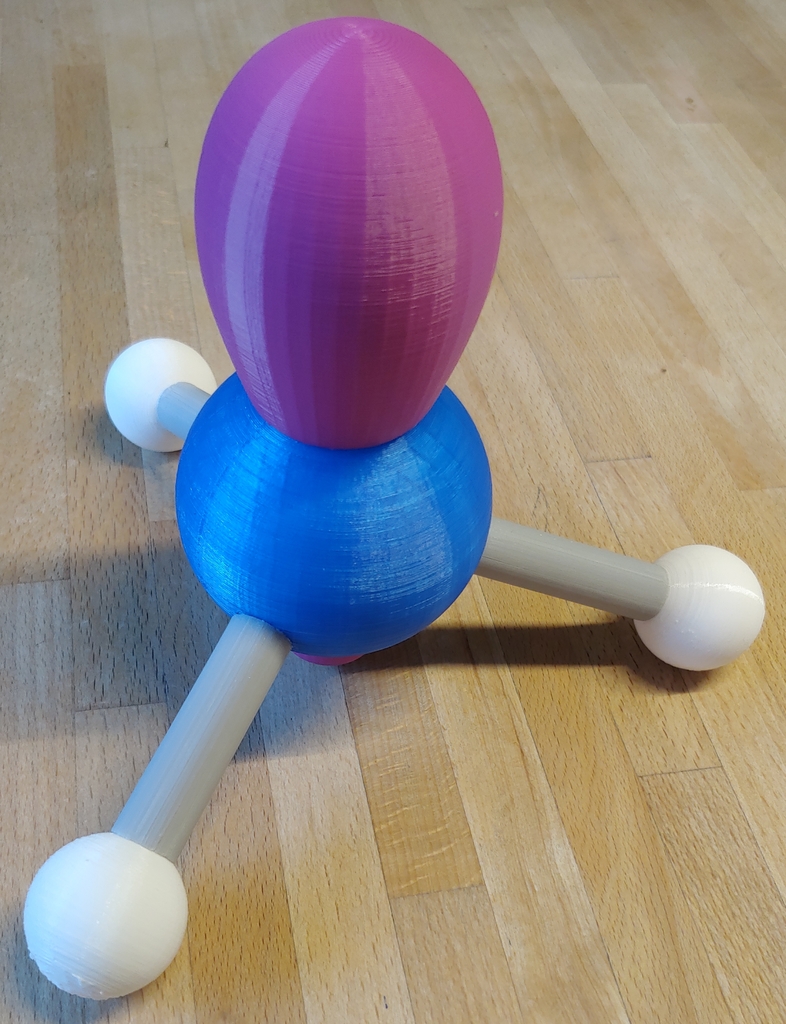
Ammonia molecule with lone pair of electrons
thingiverse
Ammonia molecule with lone pair of electrons Following the rules of VSEPR theory, it is difficult to understand why the ammonia molecule has a trigonal pyramidal coordination geometry. In most representations, it looks like a molecule that has a central atom and three ligands; the lone pair is usually not shown. According to the VESPR theory, it should be trigonal planar. In this model the orbital of the lone pair is shown. This demonstrates that the arrangement of the four electron pairs on the nitrogen is almost tetrahedral. The lone electron pair has a stronger repulsive effect on the bonding electron pairs. Therefore the bond angle between the bonding electron pairs is only 107.3 °. In terms of its dimensions, this model fits a set of molecular models (methane: thing:4289684 , Ammonia: thing:4289667 , water: thing:4256258), which are intended to support the explanation of the molecular structures with the help of the VSEPR theory. Due to their size, they are suitable for presentations. With the download two different models can be built: A "normal" model without lone pair and a model with lone pair. The bond angle and bond spacing are to scale. The covalent radii of the atoms have been halved for better visibility. However, the size ratio between nitrogen and hydrogen is correct. To build: For the "normal model": Print the "NHBond" file three times in gray and the "Hydrogen" file three times in white. "Nitrogen" is printed once in blue. The elements can then be glued together. Note that "NHBond" has a hydrogen end and an nitrogen end. This can be seen from the arching, which is flatter at the end of nitrogen. For the model with the free electron pairs: Print the "NHBond" file three times in gray and the "Hydrogen" file three times in white. " Nitrogen EP" is printed once in blue. In addition, you have to print "sp3Np" and "sp3Ns" each once in purple. The parts can then be glued together. Make sure that "NHBond" has a hydrogen end and an nitrogen end. This can be seen from the arching, which is flatter at the end of nitrogen. The lone electron pair should be glued to the nitrogen atom according to the photos. Ammoniakmolekül mit freiem Elektronenpaar Folgt man den Regeln der VSEPR-Theorie, ist es schwierig, zu verstehen, warum das Ammoniakmolekül eine trigonal-pyramidale Molekülstruktur besitzt. In den meisten Darstellungen sieht es wie ein Molekül aus, das ein Zentralatom und drei Liganden besitzt; das freie Elektronenpaar wird meistens nicht gezeigt. Nach der VESPR-Theorie sollte es demnach trigonal-planar gebaut sein. In diesem Modell wird das Orbital des freien Elektronenpaars gezeigt. Damit kann demonstriert werden, dass die Anordnung der vier Elektronenpaare am Stickstoff nahezu tetraedrisch erfolgt. Das freie Elektronenpaar hat eine stärkere abstoßende Wirkung auf die bindenden Elektronenpaare. Deswegen ist der Bindungswinkel zwischen den bindenden Elektronenpaaren nur 107.3°. Mit dem Download können zwei verschiedene Modelle gebaut werden: Ein „normales“ Modell ohne freies Elektronenpaar und ein Modell mit freiem Elektronenpaar. Bindungswinkel und Bindungsabstand sind maßstabsgetreu. Die Kovalenzradien der Atome wurden zur besseren Sichtbarkeit halbiert. Das Größenverhältnis zwischen Stickstoff und Wasserstoff stimmt jedoch. Zum Bau: Für das „normale Modell“: Drucken Sie die Datei „NHBond“ dreimal in grau und die Datei „Hydrogen“ dreimal in weiß. „Nitrogen“ wird einmal blau gedruckt. Die Elemente können dann zusammengeklebt werden. Achten Sie darauf, dass „NHBond“ ein Wasserstoff-Ende und ein Stickstoff-Ende hat. Dies ist an der Wölbung zu erkennen, die beim Stickstoff-Ende flacher ist.
With this file you will be able to print Ammonia molecule with lone pair of electrons with your 3D printer. Click on the button and save the file on your computer to work, edit or customize your design. You can also find more 3D designs for printers on Ammonia molecule with lone pair of electrons.
